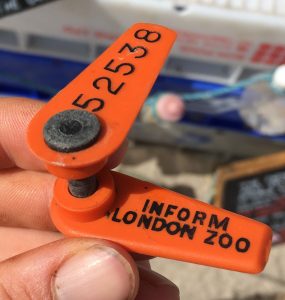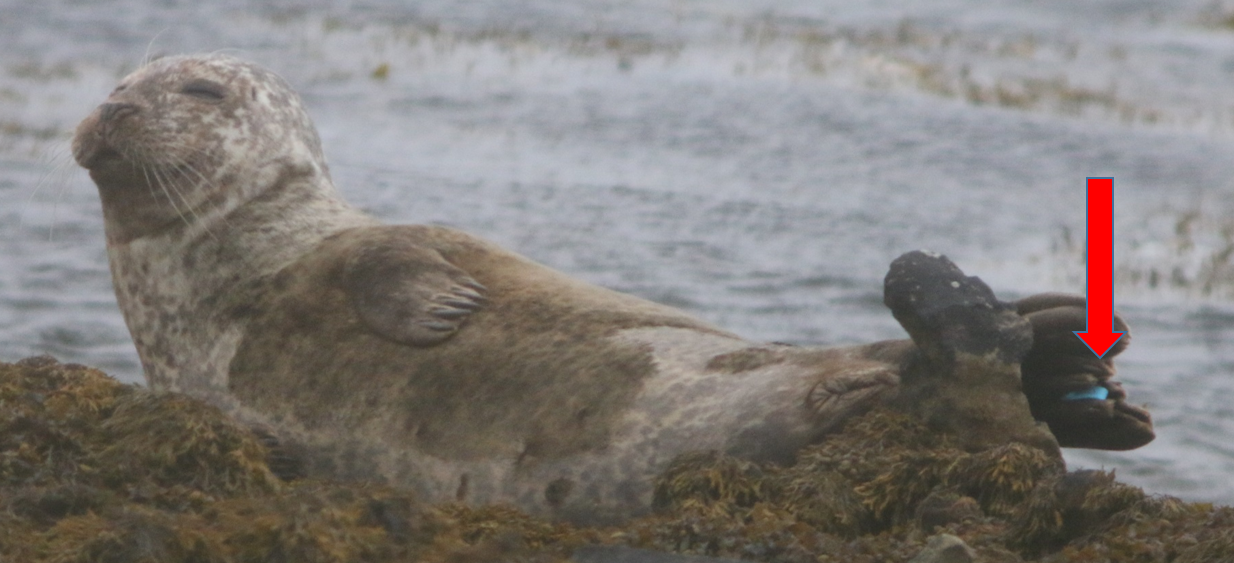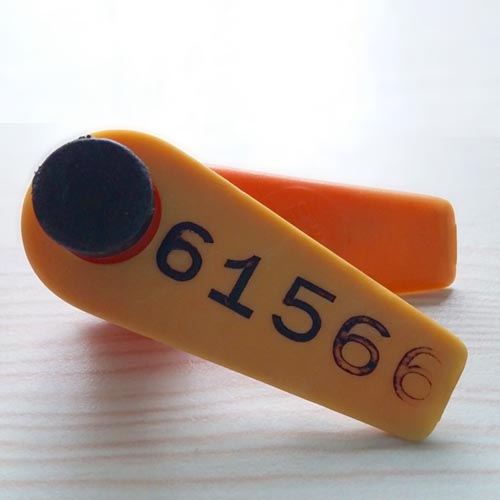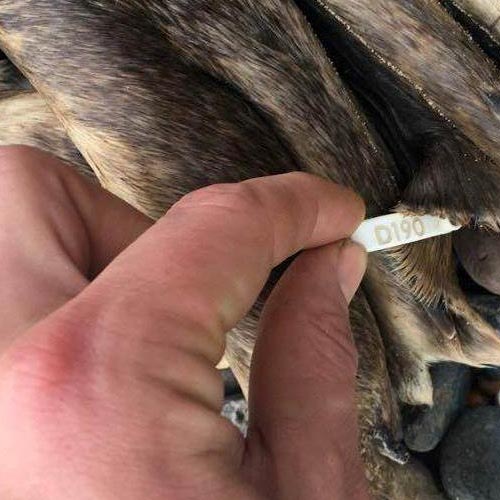Seal tag sightings
There are two types of seal tag that you may observe or find: flipper tags and electronic tracking devices (see ‘Electronic tracking devices‘ tab).
Flipper tags are used to mark seals for future identification. Such tags come in a variety of types, colours and shapes. They are deployed for research purposes (by SMRU and other European research Institutes) and by rehabilitation centres. Reports of sightings or recovery of tags are helpful for addressing research questions including those relating to survival and movement rates of seals.
The information in the tabs below (‘SMRU flipper tags‘ and ‘Flipper tags deployed by others‘) are designed to help you determine the likely origin of a flipper tag so you can then contact SMRU via the ‘Reporting form‘ or the appropriate rehab centre, as appropriate. If you have found an electronic tagging device please contact SMRU via the ‘Reporting form‘.



Important guidelines
Never disturb wildlife to obtain information about tags – keep your distance, use binoculars, minimize noise, and leave the animals at the first sign of disturbance. Know the signs; seals can be particularly vulnerable while resting on land. To learn more, see the Scottish Marine Wildlife Watching Code.
Please note that in Scotland there are a number of designated haul-out sites – these are protected by law, and harassing a seal (intentionally or recklessly) at such sites is an offence.
Do not touch animals even if dead, due to risk of disease.
If you have found an injured or dead seal, please refer to the contact details on the Stranded marine mammals page.
We are interested in sighting of SMRU tags on both live and dead animals, and if possible to obtain photos of such animals (even if dead). Below are examples of SMRU flipper tags, some may also be embossed with the words “Inform London Zoo” (London Zoo passes on any tag sightings to SMRU). The data are important for understanding more about the movements and survival of seals in the UK and European waters.
However if the tag seen matches those deployed by another organisation, please contact them directly (see ‘Flipper tags deployed by others‘ tab for guide and further details). Otherwise please report the tag to SMRU using the form on this page.
These are the three main flipper tags SMRU have deployed on seals in recent years
 |
 |
 |
|
| ORANGE | BLUE | YELLOW | WHITE |
| orange tags 3-5 digits May say “Inform London Zoo” tags starting 6 or 81 deployed by rescue centres (see tag guide) |
blue or yellow U-tags 5 digits |
white ‘Duck’ tags D followed by 3 digits |
|

There are variations on the design of these tracking devices, this is one example.
We deploy electronic tracking (telemetry) devices on seals. These are superglued onto the fur on the back of the neck of the seals, falling off during their annual moult. They record location and often data about seals activity. This information is then sent using the mobile phone system. Data like this are used for a variety of research purposes and, ultimately, for marine spatial planning. We would be grateful for any information relating to sightings of these tagged animals.
Additional data is often stored on the tag, and thus once they have fallen off the tags are valuable to us. Indeed, depending on the tag type there may be a reward for their return. Please only pick up tags no longer on an animal. If you find a dead individual with a telemetry tag, do NOT attempt to remove the tag, instead please contact SMRU immediately (SMRUsealreports@st-andrews.ac.uk).
Please do not attempt to disassemble any tracking device – the battery may still contain considerable energy and may be dangerous.
Before submitting a report, please ensure you are familiar with the Participant Information Sheet.
N.B. The usual form is currently unavailable. If you would still like to report a sighting, please send the details to SMRUsealreports@st-andrews.ac.uk. The standard information and questions from the form are given below as a guide. (“*” indicates what was a required field.)
The University of St Andrews attaches high priority to the ethical conduct of research. We therefore ask you to consider the following points before submitting your sightings. Clicking “submit” confirms that you are willing to participate in this study.
If you have any problems filling in this form or would like more information please contact SMRUsealreports@st-andrews.ac.uk
By submitting this form I agree to the following:
- I understand the contents of the Participant Information Sheet
- I have been given the opportunity to ask questions about the study and have had them answered satisfactorily.
- I understand that, after 24 hours, I will not be able withdraw my data as after this period we will catalogue an anonymised version of the data and may share it (e.g. with the original tag deployer)
- I agree to take part in the above study
- I agree to any media (pictures/videos) submitted being used for the current and/or future research studies without further consultation.
- By submitting my contact details (optional), I agree to being contacted with regard to the sightings, tag recovery, and/or potential use of media files in SMRU publications
Sighting details
- Date of sighting*:
- County*:
- Location*:
- (name of beach/ path/ nearest town)
Marking information
- Tag type*:
- electronic
- flipper
- other
- flipper
- Tag on animal*:
- yes
- no
- no
- Any other marking details:
- Tag type*:
Electronic tag
- Tag recovered:
- yes
- no
- no
- Tag number:
- Tag recovered:
Flipper tag
- Tag colour(s):
- Tag number:
- Tag letters:
- Tag type:
- rototag
- U-tag
- unknown
- U-tag
- Additional tag information:
- Tag colour(s):
Animal information
- Species:
- Grey seal
- Harbour seal
- Unknown
- Harbour seal
- Sex:
- Male
- Female
- Unknown
- Female
- Likely age:
- Juvenile
- Adult
- Unknown
- Adult
- Location:
- Land
- Water
- Water
- With pup:
- yes
- no
- unknown
- no
- Condition:
- Poor
- Fine
- Dead
- Other
- Fine
- Any identifying features/injuries:
- Species:
Other comments
- Any additional comments or information:
- Any additional comments or information:
Reporter [optional]
- Name:
- Email:
- Phone:
- Name:
Media
- Please either attach photos and/or send futher details of any high-resolution media files that you would be willing to supply.
- Please either attach photos and/or send futher details of any high-resolution media files that you would be willing to supply.
Over 20 centres across Europe rescue seals, many of which deploy flipper tags on release. Although grey seals in particular can travel >100 km, tags found in the North Sea and west coast of the British Isles were likely tagged in these respectively areas.
Our guide to seal tags is a non-exhaustive list of rescue centres/research Institutes in Europe that use flipper tags (or have done in the past). If your tag matches one of the tags in the guide, please contact the indicated organisation directly. If not, please report to us using the form on this page.



